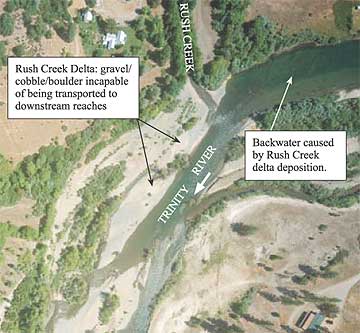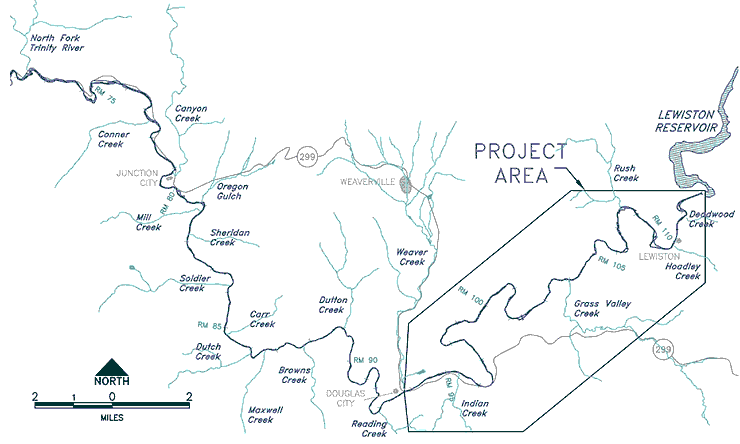TRINITY RIVER RESTORATION PROGRAM
COARSE SEDIMENT MANAGEMENT PLAN
Rivers need sediment as much as fish need water. Construction of the 538 foot high Trinity Dam abruptly eliminated the headwaters of the Trinity River from supplying any gravel and cobble to the mainstem Trinity River immediately below Lewiston Dam. Most river channel features that once provided abundant and high quality salmon habitat, such as point bars and side-channels, were lost. The Coarse Sediment Management Plan contributes to recovering these alluvial channel features and habitats by identifying coarse sediment introduction methods, volumes, and locations that will help restore a dynamic balance between coarse sediment replenished below Lewiston Dam and streamflows released from Lewiston Dam as part of the Trinity River Restoration Program Record of Decision.
 |
The disruption in the dynamic flow-sediment balance downstream of Lewiston Dam resulted in:
- Channel incision and/or river bed coarsening (i.e. from cobbles to boulders) below Lewiston Dam;
- Reduced coarse sediment storage (bars & riffles) in most reaches;
- Local coarse sediment deposition at major tributaries (Rush Creek, Grass Valley Creek, and Indian Creek) creating deltas that the Trinity River could no longer transport downstream;
- Riparian vegetation encroachment and riparian berms forming on previously mobile gravel bars, narrowing and simplifying the channel;
- Reduced aquatic habitat for yellow-legged frogs, benthic macroinvertebrates, and other aquatic species;
- Reduced Chinook salmon spawning habitat;
- Reduced Chinook salmon fry rearing habitat (determined to currently limit production on the Trinity River).
The Trinity River Coarse Sediment Management Plan (CSMP) focuses on the reach between Lewiston Dam and the confluence with Weaver Creek, where coarse sediment impacts by the Trinity River dams have been most severe. Because Indian Creek, Weaver Creek, Reading Creek, and Browns Creek deliver substantial volumes of coarse sediment to the Trinity River, coarse sediment introduction focuses on the reach from Lewiston Dam to just upstream of Indian Creek confluence. Delta management focuses from Lewiston Dam through the Indian Creek delta to the Weaver Creek confluence.
|
This article is the first in a series excerpted from Trinity River Restoration Programís brochure, Coarse Sediment Management Plan (CSMP), describing how this project benefits salmonids. Look for more in the fall issue of Conservation Almanac. |
|
To Be Continued...
|
|





